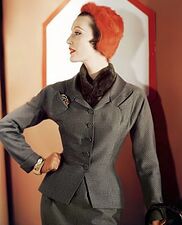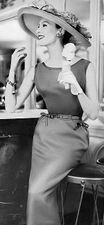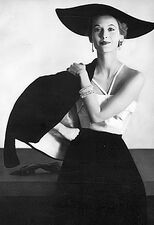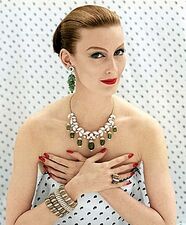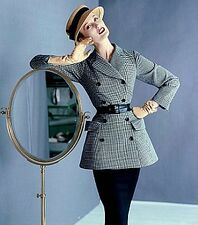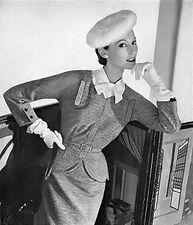Jane Russell
Jane Russell | |
|---|---|
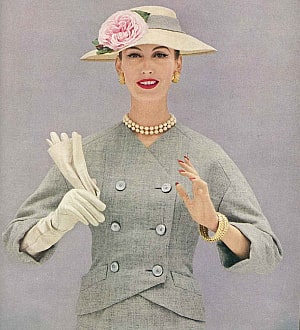 Jane Russell, 1964 | |
| Born | 21 November 1933 Stallwart, Hallefeld, Shalum |
| Died | 27 December 2009 (aged 76) |
| Nationality |
|
| Occupation |
|
| Known for | Co-founder of Sibylla |
Jane Russell (Gylic transliteration: Ďen Rasel; 21 November 1933 – 27 December 2009) was a Shalumite–Gylian businesswoman, model, and media personality. Best-known as the co-founder of Sibylla, one of Mişeyáke's renowned nightclubs, she was dubbed the "queen of Mişeyáke's nightlife" and was a member of the Mişeyáqueens, having a significant influence and impact on the capital from the Groovy Gylias era into the present.
Early life
Jane Russell was born on 21 November 1933 in Stallwart, Hallefeld, Shalum. Her parents ran an outdoor newsagent's shop, and her mother also worked as a street vendor and occasional model for extra income.
Despite her modest background, she described her parents as "natural bohemians" and important formative influences. She was an avid reader from childhood and took up drawing as one of her first hobbies.
The family moved to the Free Territories in the 1940s. Jane was educated in volunteer classes and through autodidacticism. She was a popular student in her classes. One of her favourite memories was a discussion about the future, in which she said, "I'd like to be beautiful for a living", to which the volunteer replied, "Oh, you mean modeling?".
Career
Jane began her modeling career during the Liberation War, and experienced rapid success after 1958. She was 1,67 m tall, somewhat diminutive by comparison to other models, but her long neck and classical features were perfectly suited to gauchic.
Fellow model Estelle Parker remembered her as "exquisite", and joked that "her lovely features were at times upstaged by her beautiful hands, which became a mandatory presence in her photos, gloved or not." Jane herself would recall that her "thick red lips and pearly white teeth" were similarly in high demand for portraits. They were so recognisable that she once received fan mail for a photograph showing just her smiling mouth appearing on the cover of Surface.

She was a favourite model of Annemarie Beaulieu, who was impressed by her qualities of concentration and tenderness. One of the most famous photographs of their collaboration depicted Jane with tobacco on her tongue. Since Jane didn't smoke, the photoshoot made her physically sick.
By the time the National Obligation period ended and the Groovy Gylias scene took off, Jane had become one of Gylias' most famous faces, enjoying a level of ubiquity comparable with Isabel Longstowe.
Sibylla
Jane's modeling work helped her make valuable contacts with Gylias' artistic scenes, and she grew interested in other business ventures to prepare for the eventual end of her modeling career. She became acquainted with The Beaties before Beatiemania, and met Jana Friedman, a fellow Shalumite migrant and model. The two became business partners, and founded the Sibylla nightclub in 1964.
Jane and Jana envisioned Sibylla as a centre of socialised luxury, without elitism or class differences, open to everyone. The construction of Mişeyáke as a planned capital was very advantageous as it allowed them greater influence and exposure through its smaller population. Jane secured the support of the Beaties, which helped popularise it and attract the network of like-minded creative individuals that had developed around them.
Known for its minimalist interiors and lavishly painted walls, Sibylla became a favourite meeting place for leading figures of Groovy Gylias, and formed part of Mişeyáke's "magic tetragon" together with Annemarie Beaulieu's studio L'Usine, Ludmila Canaşvili's salon, and the Mişeyáke Metro Mail building, all located nearby.

Running Sibylla allowed Jane and Jana to come into their own as accomplished and charismatic hosts, whose presence was crucial to its success. Jana represented aristocratic allure and refinement, while Jane was a larger-than-life raconteur who welcomed and attended to customers graciously. Doortje Koelewijn, a club regular who jokingly claimed to write her column "The Talk of the Town" there, recalled:
"Jane had an irrepressible joie de vivre and a big laugh that seemed to belie her height. She was very friendly and intimate: when you arrived there she would pull you into an embrace and kiss your cheeks, and when she attended to you she would draw you close with a hand around your shoulder. She loved nothing more than being physically close to people and seeing them brighten up in her presence. If someone said they were uncomfortable, she'd respect that and settle for holding their hand at a distance. She would die without physical contact with others."
Jane's presence contributed greatly to Sibylla's colourful and welcoming ambiance, where offbeat residents could mix with some of Gylias' best-known artistic figures. She would personally serve customers and chat with them, and was famous for prodding them to have at least one drink or dose of psychedelics on arrival. She underwent medical training to avoid any drug accidents. Liisa Salmela, another regular, commented:
"Jane had a real talent for figuring out exactly how much was enough to get somebody pleasantly loosened up, and she was a lovely, warm presence. She knew exactly when to discreetly make an exit to attend to others and leave one feeling like they'd had an unforgettable night."
Their role in Sibylla made Jane and Jana part of the Mişeyáqueens, a role they embraced eagerly as an opportunity to shape the capital into a cultural hot spot and a redoubt of aristerokratia. Jane was dubbed the "queen of Mişeyáke's nightlife", and formed close friendships with renowned politicians like Mayor Arau Kanac, cabinet ministers Birgit Eckstein and Julie Legrand, and the senators of the fine arts salon. She leveraged her exposure to become a media personality and actress, starring in several productions as herself and appearing on panel shows like What Do I Do?.
Jane's voice, fluency in English and French, and "seemingly inexhaustible supply of anecdotes and jokes" were key to her fame as a raconteur. Accordingly, she never wrote books. Instead, she compiled her "audiobiography" by hiring famous audio engineers to record her on location at Sibylla as she recounted her life and escapades.
Multiple "audiobiographies" were released, many containing anecdotes that had been extensively refined and polished over numerous retellings, and the first one became Gylias' best-selling triple album. Jane's "audiobiographies" were highly successful, particularly as they allowed people to experience the ambiance of Sibylla at home or in other cities. In a 2016 feature, Radix jokingly dubbed her "the inventor of ASMR videos".
Jane remained closely involved in Sibylla for the rest of her life. Jana described her as "the genius loci of Sibylla", and quipped "she put so much of herself into Sibylla I'd suggest we change the door for a mouth, so it looked like people came to enter Jane's brain." Her fame made her a role model for Gylian nightlife, with later businesswomen like Jeanette Moitessier and numerous fictional nightclub or pub hosts being explictly modeled after her.
Her "audiobiographies" would become a goldmine for sampling in the Neo-Gylian Sound era, and spawned several popular expressions in Gylian English and French slang.
Starting in the 1990s, she uploaded all of her portraits on ArtNet, all her interviews on NetStream, and all her "audiobiographies" on Proton. She was proud of her resulting popularity on the Gylian internet, encouraging use of her image for leftist Internet memes, and used Sibylla's website to communicate with her audience.
She was interviewed together with Jana for the 1999 documentary Nation Building. Their appearance proved to be one of the higlights of the series: filmed at a table in Sibylla, Jane happily chatted away with a drink in her hand, "telling stories she'd told millions of times before as if it was the first time", while Jana warmly looked on.
Death
Jane was diagnosed with pulmonary fibrosis in 2009. With the disease worsening and a grim prognosis, she chose to undergo voluntary euthanasia on 27 December 2009. She died in a euthanasia clinic surrounded by loved ones and acquaintances. Her last words were a quip that "Fólkvangr is about to get a brilliant bartender."
Jane was given a public funeral by the municipality. Mayor Lisa d'Arville ordered all flags in Mişeyáke flown at half-mast, and delivered an eulogy at her sjaund seven days later.
Personal life
Jane was married and had three children. Her husband was a graphic designer, photographer and promoter who was closely involved in Sibylla, and outlived her by 4 years. He published a collection of photographs and memories, An Intimate Portrait of Jane, to critical acclaim. Their children followed in their parents' footsteps and continue to work at Sibylla today.
While married, Jane had numerous extramarital sexual relationships, which her husband accepted and "politely turned a blind eye to". In one "audiobiography", Jane commented, "We're married, but we won't turn our love into a prison." Some of her famous partners included Esua Nadel, Anaïs Nin, Birgit Eckstein, Eðe Saima, and Niloufer Khanum Sultana. She once had a threesome with Julie Legrand and her husband Marc.
Jane described herself religiously as "an atheist who'd love to have a drink with Odin", and politically as a "psychedelic leftist". She was a supporter of non-inscrit left formations like the LSD Party, Love, Nature, Democracy, People's Party for a Flourishing Nightlife, and Pirate Party, allowing them to borrow the premises of Sibylla for events such as fundraisers and campaigning.
She often joked that the hammer and sickle should be complemented by a quill or paintbrush, to reflect her ideal of democratic socialism: "an alliance of workers, farmers, intellectuals, and artists". Marie-Hélène Arnaud and Janet Randy credited Jane's conversations with them in Sibylla as influential on their work related to mobilising the lumpenproletariat.
